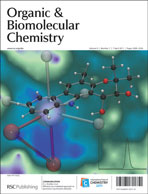Allosterically driven self-assemblies of interlocked calix[6]arene receptors†
Abstract
The construction of self-assembled receptors based on flexible concave subunits is a challenging task and constitutes an interesting approach to mimic binding processes occurring in biological systems. The receptors studied herein are based on flexible calix[6]arene skeletons bearing three (or more) acid–base functionalities at their narrow rim. When complementary, they self-assemble in a tail-to-tail manner to give a diabolo-like complex, provided that each calixarene subunit hosts a guest. The allosterically-driven multi-recognition pattern is highly selective and leads to stable quaternary adducts. In order to evaluate the scope of this system, various polyamino and polyacidic calix[6]arenes have been studied. It is shown that modifications of the nature of the wide rim substituents do not alter the efficiency of the quaternary self-assembling process, even with the more flexible
![Graphical abstract: Allosterically driven self-assemblies of interlocked calix[6]arene receptors](/en/Image/Get?imageInfo.ImageType=GA&imageInfo.ImageIdentifier.ManuscriptID=C0OB01020K&imageInfo.ImageIdentifier.Year=2011)

 Please wait while we load your content...
Please wait while we load your content...